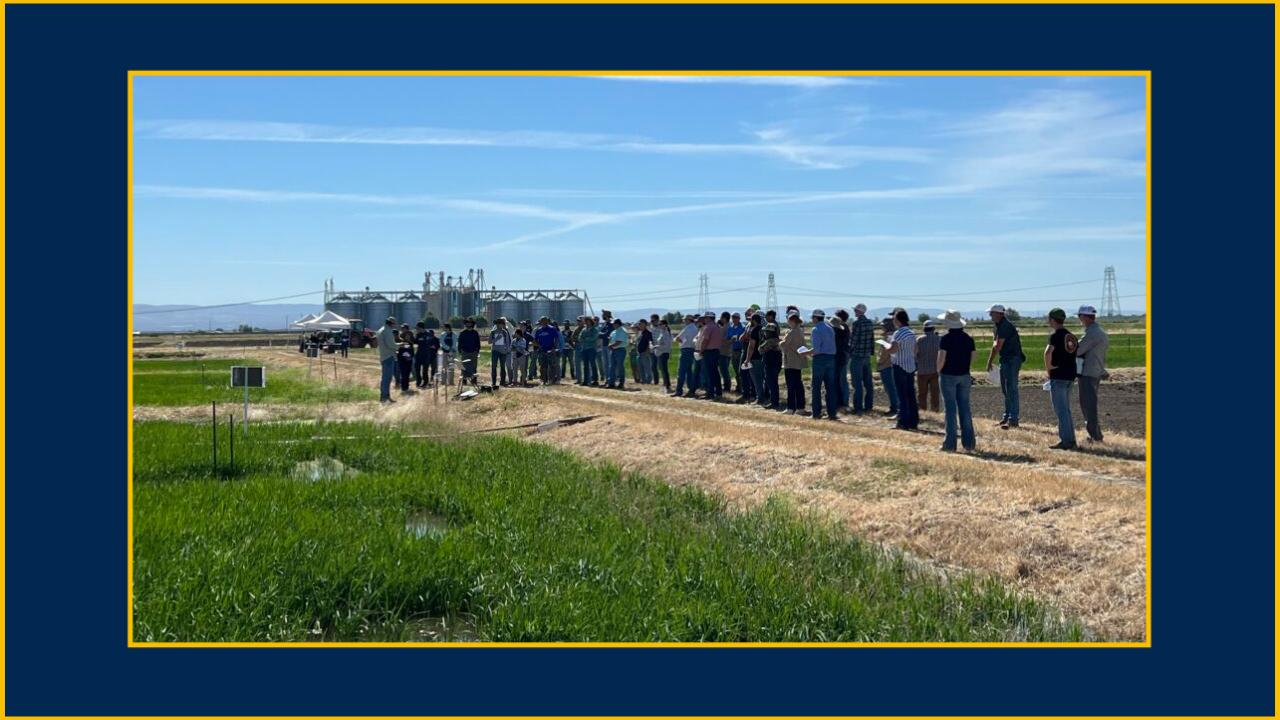
No-till, direct-seeded rice saves 15% of water, study shows
Field day offers cost-saving strategies amid scarcity
As water becomes scarcer and more expensive in California, growers of water-intensive rice are looking for ways to cut back on the precious resource. By not tilling their land and by using drill-seeders, growers can save water and money, researchers at UC Davis are showing.

In recent field trials, no-till farming was found to save roughly 6 inches of water compared to the common practice of water-seeding. That’s more than 15 percent of water typically consumed. Nawal Taaime, a Fulbright visiting scholar in the Department of Plant Sciences, conducted field trials comparing conventional irrigation practices to this alternative method.
One of the results: Plants can use water already in the soil from winter and spring rains. By not flooding the field (which is the usual practice), less water is lost to evaporation early in the season.
Visitors heard that and more discussion about no-till planting and management strategies for drill-seeded rice in California during a recent event.
California is the second-largest rice producer in the United States, growing a crop worth about $900 million per year, according to a UC Davis study. The crop contributes more than $5 billion a year and 25,000 jobs to the state's economy, according to the California Rice Commission.
A crowd of rice growers, pest control applicators, researchers and more gathered for the No-Till Rice Field Day at the Rice Experiment Station in Biggs, in the northern Central Valley, on June 21. Bruce Linquist, a rice specialist and professor of Cooperative Extension in the Department of Plant Sciences, organized an agenda that encompassed various types of no-till, drill-seeded planting.
Members of Linquist's lab spoke about experiments conducted in the no-till rice trials. Ph.D candidate Mia Godbey detailed the results of treatments using gibberellic acid, a plant hormone, to encourage seedlings to emerge rapidly. GA is commonly used in rice production in the southern United States. Godbey found small positive effects of using GA, which allows growers to plant seeds up to 1.5 inches deep, reaching soil that is moist enough for the seeds to germinate.

Pest and weed management strategies
UCCE rice advisors noted pest management strategies that may become more pertinent as drill-seeded acreage increases. Luis Espino discussed the insects and diseases that no-till, drill-seeded rice may harbor. Whitney Brim-Deforest (a UC Davis graduate) explained weed management strategies available to drill-seeded rice growers. She particularly stressed the need for more research in this area.
Kelby Sheppard, a rice grower who is testing drill-seeded rice, talked about his planting experience this year. He offered practical notes on challenges he faced when using the drill-seeded system.
Dustin Harrell, director of the Rice Experiment Station, offered remarks on no-till rice planting based on his expertise in both rice breeding and Southern rice practices. The station is operated by the California Cooperative Rice Research Foundation.
Resources
Taaime is in the lab of Cameron Pittelkow, an associate professor in the department. Taaime has been working with Linquist on this research and soon will join the Linquist lab as a post-doctoral researcher. Godbey is in the horticulture and agronomy graduate group and also in the Linquist lab.
- Handouts from the field day detailing the research presented can be found here.
- More information about rice research can be found here.
- Read Linquist’s blog about drill-seeding rice here. His trials show no-till rice cultivation can save growers up to .5 acre-feet and money on tillage, plus avoid injury to the crop from tadpole shrimp and midge.
- Read more rice news here.
Media Resources
Trina Kleist, communications specialist for the UC Davis Department of Plant Sciences, contributed to this report. The original version of this article was published by the California Rice Commission.
- Trina Kleist, UC Davis Department of Plant Sciences, tkleist@ucdavis.edu, (530) 754-6148 or (530) 601-6846
